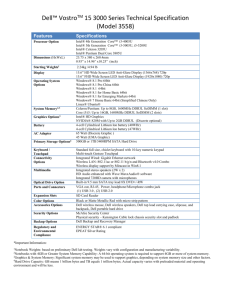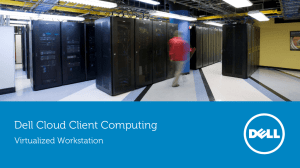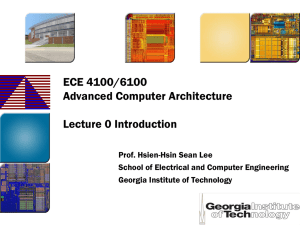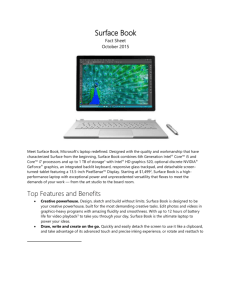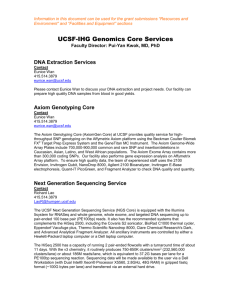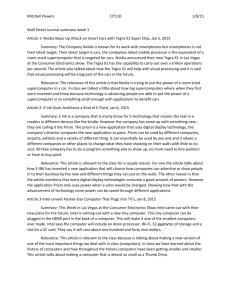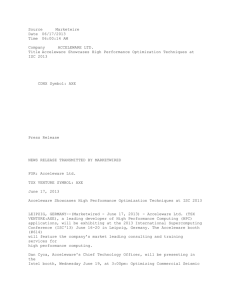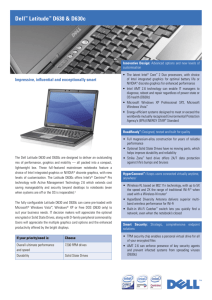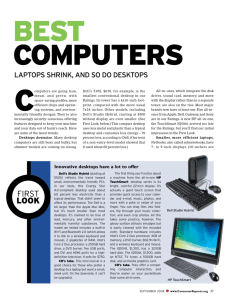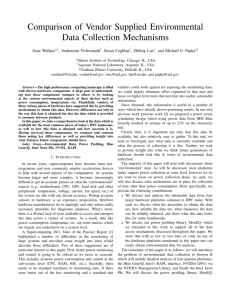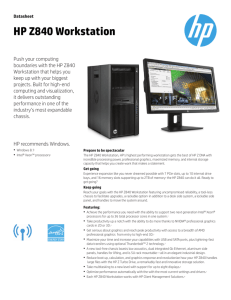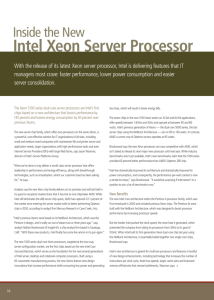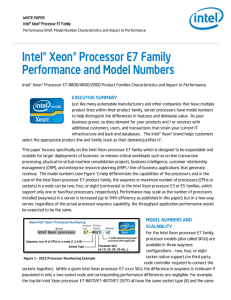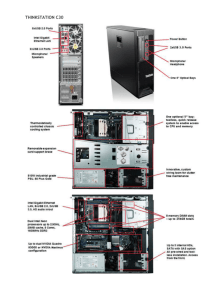here - University of North Dakota School of Medicine and Health
advertisement
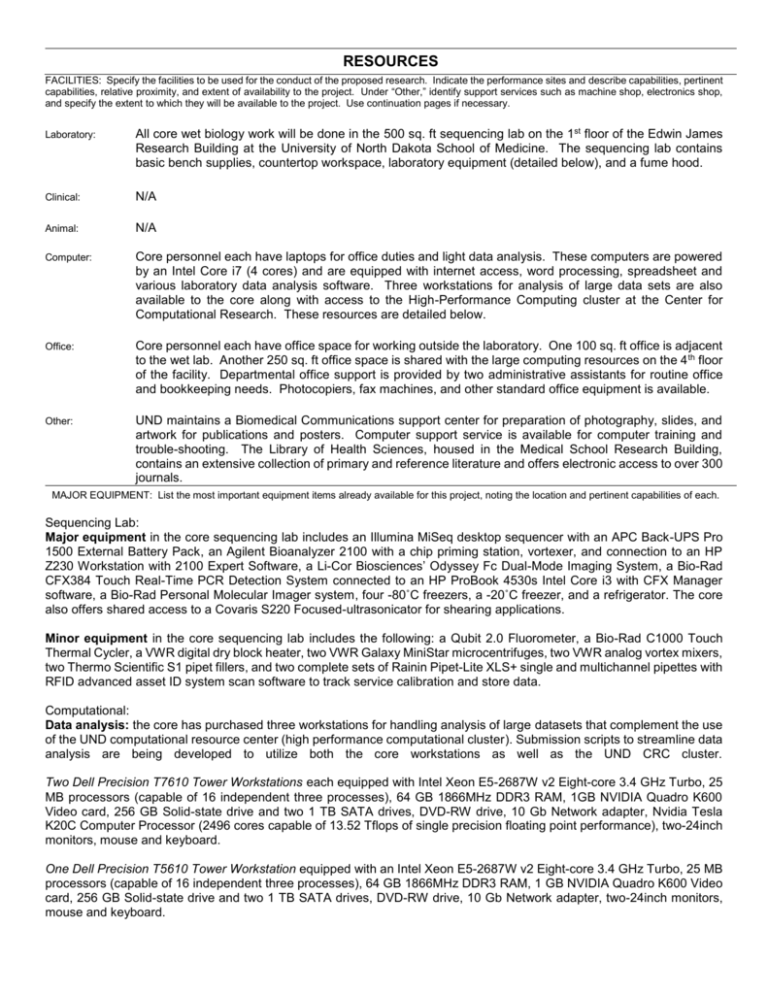
RESOURCES FACILITIES: Specify the facilities to be used for the conduct of the proposed research. Indicate the performance sites and describe capabilities, pertinent capabilities, relative proximity, and extent of availability to the project. Under “Other,” identify support services such as machine shop, electronics shop, and specify the extent to which they will be available to the project. Use continuation pages if necessary. Laboratory: All core wet biology work will be done in the 500 sq. ft sequencing lab on the 1st floor of the Edwin James Research Building at the University of North Dakota School of Medicine. The sequencing lab contains basic bench supplies, countertop workspace, laboratory equipment (detailed below), and a fume hood. Clinical: N/A Animal: N/A Computer: Core personnel each have laptops for office duties and light data analysis. These computers are powered by an Intel Core i7 (4 cores) and are equipped with internet access, word processing, spreadsheet and various laboratory data analysis software. Three workstations for analysis of large data sets are also available to the core along with access to the High-Performance Computing cluster at the Center for Computational Research. These resources are detailed below. Office: Core personnel each have office space for working outside the laboratory. One 100 sq. ft office is adjacent to the wet lab. Another 250 sq. ft office space is shared with the large computing resources on the 4 th floor of the facility. Departmental office support is provided by two administrative assistants for routine office and bookkeeping needs. Photocopiers, fax machines, and other standard office equipment is available. Other: UND maintains a Biomedical Communications support center for preparation of photography, slides, and artwork for publications and posters. Computer support service is available for computer training and trouble-shooting. The Library of Health Sciences, housed in the Medical School Research Building, contains an extensive collection of primary and reference literature and offers electronic access to over 300 journals. MAJOR EQUIPMENT: List the most important equipment items already available for this project, noting the location and pertinent capabilities of each. Sequencing Lab: Major equipment in the core sequencing lab includes an Illumina MiSeq desktop sequencer with an APC Back-UPS Pro 1500 External Battery Pack, an Agilent Bioanalyzer 2100 with a chip priming station, vortexer, and connection to an HP Z230 Workstation with 2100 Expert Software, a Li-Cor Biosciences’ Odyssey Fc Dual-Mode Imaging System, a Bio-Rad CFX384 Touch Real-Time PCR Detection System connected to an HP ProBook 4530s Intel Core i3 with CFX Manager software, a Bio-Rad Personal Molecular Imager system, four -80˚C freezers, a -20˚C freezer, and a refrigerator. The core also offers shared access to a Covaris S220 Focused-ultrasonicator for shearing applications. Minor equipment in the core sequencing lab includes the following: a Qubit 2.0 Fluorometer, a Bio-Rad C1000 Touch Thermal Cycler, a VWR digital dry block heater, two VWR Galaxy MiniStar microcentrifuges, two VWR analog vortex mixers, two Thermo Scientific S1 pipet fillers, and two complete sets of Rainin Pipet-Lite XLS+ single and multichannel pipettes with RFID advanced asset ID system scan software to track service calibration and store data. Computational: Data analysis: the core has purchased three workstations for handling analysis of large datasets that complement the use of the UND computational resource center (high performance computational cluster). Submission scripts to streamline data analysis are being developed to utilize both the core workstations as well as the UND CRC cluster. Two Dell Precision T7610 Tower Workstations each equipped with Intel Xeon E5-2687W v2 Eight-core 3.4 GHz Turbo, 25 MB processors (capable of 16 independent three processes), 64 GB 1866MHz DDR3 RAM, 1GB NVIDIA Quadro K600 Video card, 256 GB Solid-state drive and two 1 TB SATA drives, DVD-RW drive, 10 Gb Network adapter, Nvidia Tesla K20C Computer Processor (2496 cores capable of 13.52 Tflops of single precision floating point performance), two-24inch monitors, mouse and keyboard. One Dell Precision T5610 Tower Workstation equipped with an Intel Xeon E5-2687W v2 Eight-core 3.4 GHz Turbo, 25 MB processors (capable of 16 independent three processes), 64 GB 1866MHz DDR3 RAM, 1 GB NVIDIA Quadro K600 Video card, 256 GB Solid-state drive and two 1 TB SATA drives, DVD-RW drive, 10 Gb Network adapter, two-24inch monitors, mouse and keyboard. High-Performance Computing (HPC) cluster at the Center for Computational Research here at UND (UND-CRC) which has 32 Dell PowerEdge 720 server compute nodes each with 3.4 GHz four-core Sandy Bridge processors and 64 GB RAM. In addition, we have shared access to eight Nvidia Tesla K20 and eight Intel Xeon Phi cards. Data Storage: Data collected by the core and UND epigenetic investigators is being stored redundantly on the HighAvailability NSS Dell storage appliance (110 TB usable space with weekly backups, located at the UND-CRC) and on a Dell PowerEdge R720xd (6 core Intel Xeon processor) with a dedicated NIC setup with 4 TB SATA hard drive platters configured for file versioning configured with RAID 6 Disk Redundancy to protect from disk failure. The server's data is replicated to a second (off site) server via DFS Replication, and VSS shadow copies of the data have been implemented to allow restoration of any folder or file, back to a previous state. This asset was created to allow for requisite storage and sharing of the large amount of data generated by sequencing experiments. Permission is administered by the core, in conjunction with Medical School IT, and set up to provide all investigators and their lab members storage space as well as provide them access to other group’s data to facilitate and encourage collaboration.



